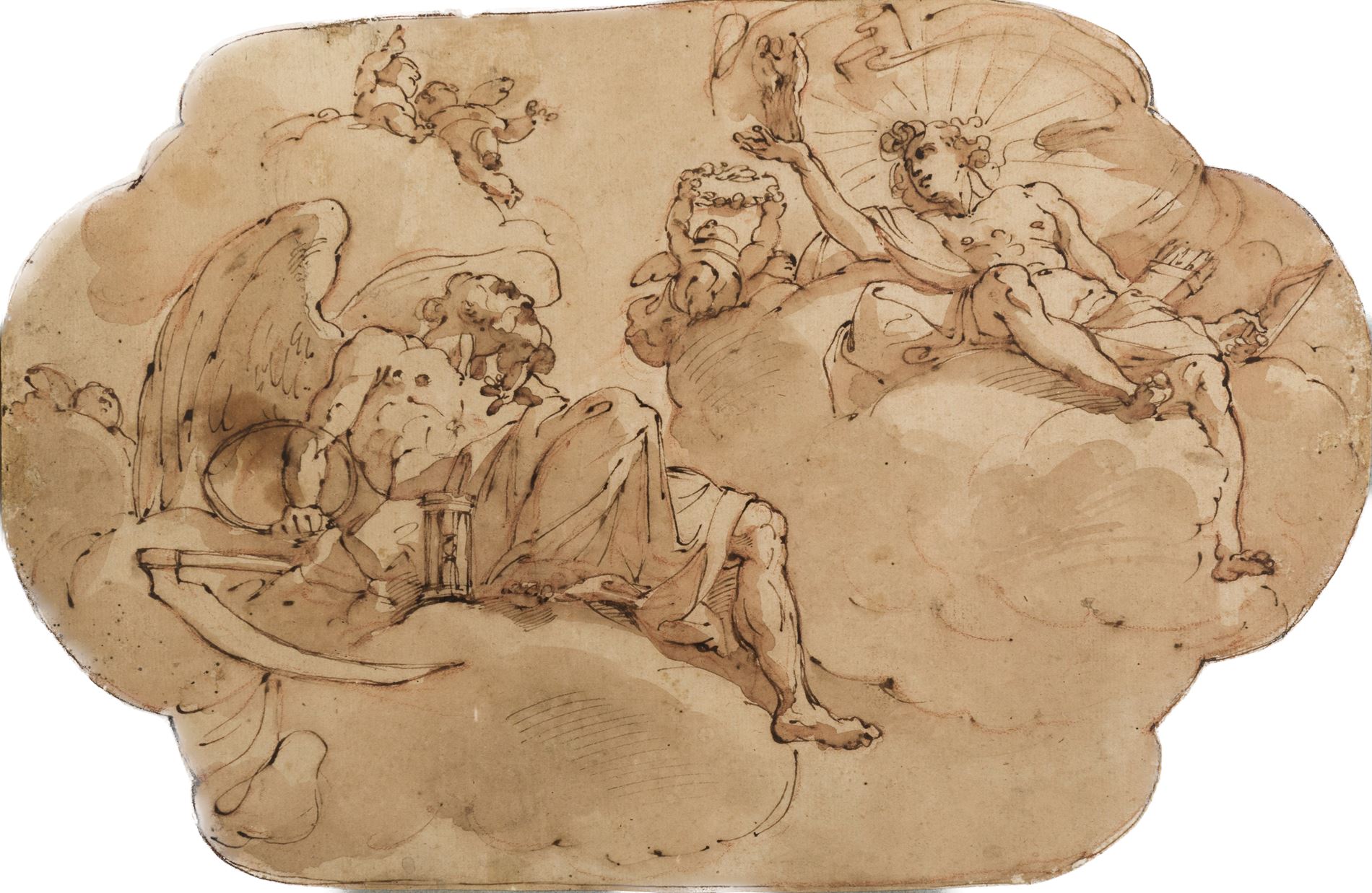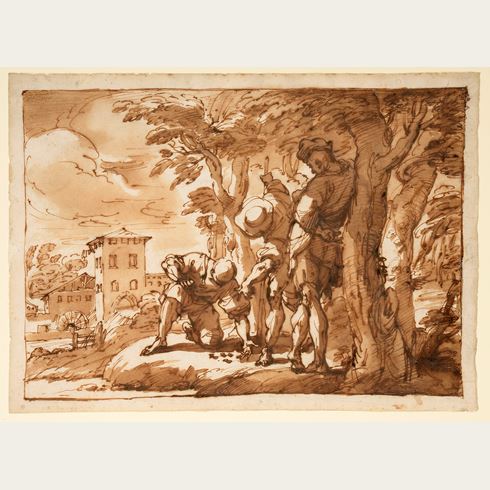Ubaldo GANDOLFI
(San Matteo della Decima 1728 - Rome 1781)
Chronos and Apollo
Sold
Pen and brown ink and brown wash, over an underdrawing in red chalk, with framing lines in brown ink.
Laid down on an 18th or early 19th century mount, inscribed Ubaldo Gandolfi on the reverse.
Further inscribed Ubaldo Gandolfi on an intermediate backing sheet.
Inscribed Ubaldo Gandolfi and G. Bentivoglio on the backing paper of the original frame.
197 x 303 mm. (7 3/4 x 11 7/8 in.) at greatest dimensions.
Laid down on an 18th or early 19th century mount, inscribed Ubaldo Gandolfi on the reverse.
Further inscribed Ubaldo Gandolfi on an intermediate backing sheet.
Inscribed Ubaldo Gandolfi and G. Bentivoglio on the backing paper of the original frame.
197 x 303 mm. (7 3/4 x 11 7/8 in.) at greatest dimensions.
This is a finished preparatory study for Ubaldo Gandolfi’s ceiling fresco of Apollo and Chronos, painted in the first half of the 1770s in the Palazzo Bovio Silvestri in Bologna. Although the artist painted an extensive series of frescoes in two other rooms in the same palace, in collaboration with the quadraturisti Serafino Barozzi and Davide Zanotti, the ceiling fresco of Apollo and Chronos, which is in a private wing of the building, remains relatively little-known today. The composition of the present sheet is close to that of the final painting, which likewise shows Apollo holding a statue of the Three Graces in one hand and his bow in the other, while the winged Chronos is accompanied by an hourglass and a scythe. That Gandolfi had initially planned the fresco as a vertical composition, however, is seen in another extant study for it; a pen and ink drawing, of similar dimensions, in the Schloss Fachsenfeld collection in Stuttgart. A third pen and ink study of Chronos and Apollo, also vertical in orientation and with the positions of the protagonists reversed from the Stuttgart drawing, is in the Szépmüvészeti Múzeum in Budapest.
Two further works by Ubaldo Gandolfi may be tentatively related to the Palazzo Bovio Silvestri ceiling. A pen and ink drawing of a standing Apollo with attendant putti, in a private collection in Bologna, may be a first idea for the same figure in the fresco. A small circular oil sketch modello depicting Apollo seated in clouds, in the Pinacoteca Nazionale in Bologna, has also been connected with the Chronos and Apollo.
Lent by the Contessa Giovanna Bentivoglio Gilli, a descendant of the noble Bentivoglio family that had served as the de facto rulers of Bologna in the 15th and early 16th centuries, the present sheet was included in the Mostra del Settecento Bolognese, a seminal exhibition of Emilian art held in Bologna in 1935.
Two further works by Ubaldo Gandolfi may be tentatively related to the Palazzo Bovio Silvestri ceiling. A pen and ink drawing of a standing Apollo with attendant putti, in a private collection in Bologna, may be a first idea for the same figure in the fresco. A small circular oil sketch modello depicting Apollo seated in clouds, in the Pinacoteca Nazionale in Bologna, has also been connected with the Chronos and Apollo.
Lent by the Contessa Giovanna Bentivoglio Gilli, a descendant of the noble Bentivoglio family that had served as the de facto rulers of Bologna in the 15th and early 16th centuries, the present sheet was included in the Mostra del Settecento Bolognese, a seminal exhibition of Emilian art held in Bologna in 1935.
Ubaldo Gandolfi entered the Accademia Clementina in Bologna at an early age, and by 1745 had already won a prize for figure drawing, earning two more in the next four years. Between 1749 and 1759, however, he does not appear in any records of the Accademia, and it may be supposed that he spent some of this period travelling around Italy. (His biographer Marcello Oretti notes that the artist ‘vidde Firenze, Venezia ed altre famose scuole.’) One of his first independent projects was the decoration of several rooms in the Palazzo Malvasia in Bologna, commissioned around 1758 by the Bolognese nobleman and art historian Carlo Cesare Malvasia.
Together with his younger brother Gaetano, Ubaldo visited Venice in 1760; a trip that was to have a significant impact on the artist’s later work, with its vigorous brushwork and expressive treatment of colour. Throughout much of his career Ubaldo maintained close contacts with the Accademia Clementina, where in 1761 he was appointed one of four direttori di figura, or professors of life drawing. One of his most important patrons was the Marchese Gregorio Casali, a fellow member of the Accademia Clementina, who commissioned several works from the artist, notably two large paintings of Perseus and Andromeda and Selene and Endymion for the Palazzo Pubblico in Bologna. Apart from an Apotheosis of Hercules in the Palazzo Malvezzi in Bologna, relatively little of his large-scale mural decorations survive today. Over a career of some thirty years, Ubaldo Gandolfi was active as a painter of frescoes, altarpieces and mythological scenes, as well as a charming series of small, informal portraits of women and children that have the appearance of character studies. He also worked as a sculptor, and a handful of terracotta sculptures of saints are known today. However, he seems to have struggled to win commissions for significant religious pictures, and never achieved the level of success enjoyed by his brother Gaetano.
Like his brother, Ubaldo Gandolfi was highly regarded as a draughtsman in his lifetime, as is noted by Oretti, who adds that the artist continued to attend life drawing classes at the Accademia Clementina well into his independent career. Many of Ubaldo’s extant drawings remain unconnected to surviving paintings by the artist, and several have the appearance of being independent compositions. In fact, it has been suggested that, ‘chronically lacking commissions, [he] often fulfilled his creative urges and “kept his hand in” by making drawings.’
Provenance
The Contessa Giovanna Bentivoglio Gilli, Bologna, by 1935, with her red wax seals on the back of the original frame
Private collection, Bologna
Private collection, Massachusetts.
Private collection, Bologna
Private collection, Massachusetts.
Literature
Guido Zucchini, ed., Mostra del Settecento Bolognese, exhibition catalogue, Bologna, 1935, p.128, no.238 (‘Apollo e il tempo. Disegno a penna e sepia: 30,5 x 19,5’); Lidia Bianchi, I Gandolfi, Rome, 1936, p.130, no.12 (‘Prop. Contessa Giovanna Bentivoglio Gilli, Apollo e il tempo, penna e sepia, 30,5 x 19,5’); Lidia Bianchi, I Gandolfi: Pittori del Settecento Bolognese, Rome, 1938, p.122, no.12; Christel Thiem, Disegni di Artisti Bolognesi dal Seicento all’Ottocento della Collezione Schloss Fachsenfeld e della Graphische Sammlung Staatsgalerie Stuttgart, exhibition catalogue, Bologna, 1983, p.152, under no.90; Donatella Biagi Maino, Ubaldo Gandolfi, Turin, 1990, p.263, under no.69; Prisco Bagni, I Gandolfi: Affreschi dipinti bozzetti disegni, Cittadella, 1992, p.640, under no.615 (incorrectly identified as the Schloss Fachsenfeld drawing); Andrea Czére, 18th Century Italian Drawings in the Budapest Museum of Fine Arts: A Complete Catalogue, Budapest, 2022, p.168, under no.136.
Exhibition
Bologna, Palazzo Comunale, Mostra del Settecento Bolognese, 1935, no.238 (lent by the Contessa Bentivoglio Gilli).










